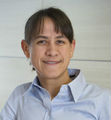Events
Plasmonic metal oxide nanocrystals
April 5, 2016 at 4:30pm/34-401A
Delia Milliron
Department of Chemical Engineering, The University of Texas at Austin

Degenerately doped metal oxide semiconductors, like ITO, exhibit plasmonic resonance at near and mid-infrared wavelengths tunable by varying their composition. Nanocrystals of many such materials have now been synthesized and applications are emerging that leverage the responsiveness of their localized surface plasmon resonance (LSPR) to electronic charging and discharging. For example, we are developing a new class of electrochromic glass that can dynamically control heat loads and daylighting in buildings to save energy and enhance comfort of building occupants. Further applications of these novel plasmonic nanocrystals will hinge, in part, on their ability to concentrate infrared light into nanoscale volumes and to enhance electronic and vibrational state transitions via associated field enhancement effects. Through simulations, we have predicted high field enhancement factors exceeding 300x for faceted nanocrystals. Experimentally, we can assess the potential of plasmonic oxide nanocrystals for field enhancement by observing the homogeneous LSPR linewidth, which is inversely related to the dephasing time. We have sought to distinguish this intrinsic linewidth from the heterogeneous broadening that is always present for colloidal nanoparticles. Measuring LSPR spectra of individual nanocrystals by tip-enhanced synchrotron FTIR spectroscopy we find single nanocrystals can have linewidths less than half of the corresponding ensembles. Thus, the dephasing times are long and plasmonic oxide nanocrystals have great potential for diverse applications in energy. I will conclude with an outlook on how materials chemistry enables the tuning of LSPR properties by design.
Delia J. Milliron is an Associate Professor in the McKetta Department of Chemical Engineering at the University of Texas at Austin and a Fellow of the Henry Beckman Professorship. She also serves as an Associate Editor for the journal Nano Letters. Dr. Milliron received her PhD in Chemistry from the University of California, Berkeley, in 2004. From 2004 to 2008 she worked for IBM’s research division, initially as a postdoctoral researcher and subsequently as a member of the research staff. In 2008, she joined the research staff at the Molecular Foundry, Lawrence Berkeley National Lab, where she served as the Director of the Inorganic Nanostructures Facility and later as the Deputy Director. Dr. Milliron’s awards include a Sloan Research Fellowship, a DOE Early Career award and a Resonate Award from Caltech’s Resnick Institute. Her research is motivated by the potential for nanomaterials to introduce new functionality to and reduce manufacturing costs of energy technologies. Her group’s activities span from the fundamental chemistry and assembly pathways of nanomaterials to device integration and characterization.






